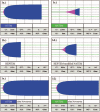Endogenous Heparinoids May Cause Bleeding in Mucor Infection and can be Detected by Nonactivated Thromboelastometry and Treated by Recombinant Activated Factor VII: A Case Report
- PMID: 26937941
- PMCID: PMC4779038
- DOI: 10.1097/MD.0000000000002933
Endogenous Heparinoids May Cause Bleeding in Mucor Infection and can be Detected by Nonactivated Thromboelastometry and Treated by Recombinant Activated Factor VII: A Case Report
Abstract
Mucormycosis is an aggressive fungal infection, which invades endothelial cells of blood vessels. This condition might lead to destruction of endothelium and release of heparin-like substances to the bloodstream and cause life-threatening bleeding, which is not well described in the literature.We present a patient with mucormycosis who experienced life-threatening bleeding, although no standard laboratory test could detect any coagulopathy.The cause of bleeding-coagulopathy was detected only by nonactivated thromboelastometry (NATEM), which revealed the presence of heparin-like substances. After treatment with recombinant activated FVII rotational thromboelastometry, results improved and the patient stopped bleeding. Regular application of the drug was necessary during acute phase of infection to prevent further bleeding.In this case report, we show that NATEM can detect the presence of heparin-like substances in bleeding patient with mucormycosis infection and that recombinant activated FVII can be used to stop and prevent bleeding until infection resolves.
Conflict of interest statement
The authors report no conflicts of interest.
Figures

References
-
- Bowbrick VA, Mikhailidis DP, Stansby G. The use of citrated whole blood in thromboelastography. Anesth Analg 2000; 90:1086–1088. - PubMed
-
- Durila M. Nonactivated thromboelastometry able to detect fibrinolysis in contrast to activated methods (EXTEM, INTEM) in a bleeding patient. Blood Coagul Fibrinolysis 2015; [Epub ahead of print] PMID: 26656899. - PubMed
-
- Senzolo M, Coppell J, Cholongitas E, et al. The effects of glycosaminoglycans on coagulation: a thromboelastographic study. Blood Coagul Fibrinolysis 2007; 18:227–236. - PubMed
Publication types
MeSH terms
Substances
LinkOut - more resources
Full Text Sources
Other Literature Sources
Medical

